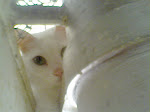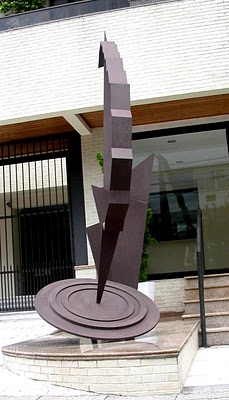
Nagasaki (August 9, 1945)Events: Dawn of the Atomic Era, 1945
The next break in the weather over Japan was due to appear just three days after the attack on Hiroshima, to be followed by at least five more days of prohibitive weather. The plutonium bomb, nicknamed "Fat Man," was rushed into readiness to take advantage of this window. No further orders were required for the attack. Truman's order of July 25th had authorized the dropping of additional bombs as soon as they were ready. At 3:47 a.m. on August 9, 1945, a B-29 named Bock's Car lifted off from Tinian and headed toward the primary target: Kokura Arsenal, a massive collection of war industries adjacent to the city of Kokura.
The aircraft commander, Major Charles W. Sweeney, ordered the arming of the bomb only ten minutes after take-off so that the aircraft could be pressurized and climb above the lightning and squalls that menaced the flight all the way to Japan.
The next break in the weather over Japan was due to appear just three days after the attack on Hiroshima, to be followed by at least five more days of prohibitive weather. The plutonium bomb, nicknamed "Fat Man," was rushed into readiness to take advantage of this window. No further orders were required for the attack. Truman's order of July 25th had authorized the dropping of additional bombs as soon as they were ready. At 3:47 a.m. on August 9, 1945, a B-29 named Bock's Car lifted off from Tinian and headed toward the primary target: Kokura Arsenal, a massive collection of war industries adjacent to the city of Kokura.
The aircraft commander, Major Charles W. Sweeney, ordered the arming of the bomb only ten minutes after take-off so that the aircraft could be pressurized and climb above the lightning and squalls that menaced the flight all the way to Japan.

Nagasaki was an industrial center and major port on the western coast of Kyushu. As had happened at Hiroshima, the "all-clear" from an early morning air raid alert had long been given by the time the B-29 had begun its bombing run. A small conventional raid on Nagasaki on August 1st had resulted in a partial evacuation of the city, especially of school children. There were still almost 200,000 people in the city below the bomb when it exploded. The hurriedly-targeted weapon ended up detonating almost exactly between two of the principal targets in the city, the Mitsubishi Steel and Arms Works to the south, and the Mitsubishi-Urakami Torpedo Works (right) to the north. Had the bomb exploded farther south the residential and commercial heart of the city would have suffered much greater damage.
The explosion affected a total area of approximately 43 square miles. About 8.5 of those square miles were water, and 33 more square miles were only partially settled. Although the destruction at Nagasaki has generally received less worldwide attention than that at Hiroshima, it was extensive nonetheless. Almost everything up to half a mile from ground zero was completely destroyed, including even the earthquake-hardened concrete structures that had sometimes survived at comparable distances at Hiroshima. According to a Nagasaki Prefectural report "men and animals died almost instantly" within 1 kilometer (0.62 miles) of the point of detonation. Almost all homes within a mile and a half were destroyed, and dry, combustible materials such as paper instantly burst in to flames as far away as 10,000 feet from ground zero. Of the 52,000 homes in Nagasaki, 14,000 were destroyed and 5,400 more seriously damaged. Only 12 percent of the homes escaped unscathed. . A U.S. Navy officer who visited the city in mid-September reported that, even over a month after the attack, "a smell of death and corruption pervades the place." As at Hiroshima, the psychological effects of the attack were undoubtedly considerable.
As with the estimates of deaths at Hiroshima, it will never be known for certain how many people died as a result of the atomic attack on Nagasaki. The best estimate is 40,000 people died initially, with 60,000 more injured.
As with the estimates of deaths at Hiroshima, it will never be known for certain how many people died as a result of the atomic attack on Nagasaki. The best estimate is 40,000 people died initially, with 60,000 more injured.
By January 1946, the number of deaths probablyapproached 70,000, with perhaps ultimately twice
that number dead total within five years.For those areas of Nagasaki affected by theexplosion, the death rate was comparable to that at Hiroshima.










4 comments:
Very bad project
Vraiment une chose horrible, malheureusement ils continuent de penser que seuls ils ont le droit d'avoir des armes atomiques.
Well, war is war we need to defend.
The plutonium for Fat Man was produced about an hour's drive north of here. We recently toured the reactor.
As a scientist, my college major was chemistry, I am fascinated with the reactor. As a person I think we were seriously wrong to use the weapon.
Post a Comment